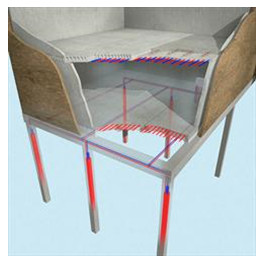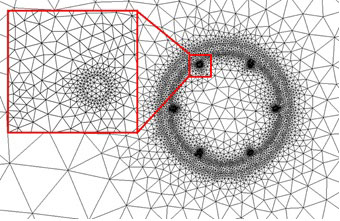Thermal Piles
Thermoactive foundations
Ground source energy can be efficient and economic for providing heating and cooling to buildings, especially where the heating load in winter is similar to the cooling load in summer. Heat exchange with the ground can be via boreholes or via thermoactive foundations.
In thermoactive foundations, foundation piles, also referred to as "thermal piles" or as "energy piles", are used as heat exchangers for supplying low temperature heat to heat pumps. They can also be used for underground storage of warmth supplied by road solar collectors.

Thermoactive foundations for underground storage of low temperature heat.
In the work on thermoactive foundations, a number of promising innovations, such as the use of thermally enhanced concrete have been analysed, using calibrated high detail 3D-FEM (Finite Element Models).

Calibrated high detail 3D-finite element model analysing the performance of thermal piles using new materials.
The E-Hub project investigated the use of thermally enhanced materials for energy piles and found in simulation runs that thermally enhanced concrete can increase the base load heat transfer performance by up to 25% and the peak load performance by 25-30%.
Further details are available in: Integrated renewable energy generation.
Solintel and HSW have also produced a simple Matlab model for thermal piles to be used in the simulation tool for the assessment of districts.
Energy storage studies within the E-Hub project
Thermochemical storage technology is being studied by ECN.
Another promising thermochemical storage technology is being studied by TNO.
Distributed heat storage is being studied by VITO.
